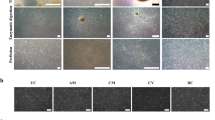Placentas from women aged 25-32 years with normal course of gestation were studied. It is essential to stick to certain methodological approaches for preparing viable multipotent mesenchymal stromal cell culture and to carry out morphological (macro and micro) evaluation of the chorionic villi, umbilical cords, and placentas. At stage I of the study, patients’ histories, labor course, and examinations of the newborns should be analyzed to exclude women with genital and extragenital diseases. At stage II, it is essential to stick to special regulations and methods for collection of specimens of the cord, amnion, and placental tissue proper. Histological control of the placental structures collected for multipotent mesenchymal stromal cell culturing is obligatory.
Similar content being viewed by others
References
Nizyaeva NV, Volkova YS, Mullabaeva SM, Shchegolev AI. The methodical bases for placental tissue examination and the optimization of material pre-preparation regimens. Akush. Gin. 2014;(8):10-18. Russian.
Rylova YV, Milovanova NV, Gordeeva MN, Savilova AM. Characteristics of multipotent mesenchymal stromal cells from human terminal placenta. Bull. Exp. Biol. Med. 2015; 159(2):253-257.
Savilova AM, Zakharov AV, Metlyuk EA, Serdyuk YV, Veryasov VN, Krasnyi AM, Trofimov DY. Comparison of the expression of immunomodulatory factors in cultures of mesenchymal stromal cells from human extraembryonic tissues. Bull. Exp. Biol. Med. 2014;158(4):555-560.
Shchegolev AI, Dubova EA, Pavlov KA. Placenta Morphology. Moscow, 2010. Russian.
Benirschke K, Burton GJ, Baergen RN. Pathology of the Human Placenta. 6th ed. New York, 2012.
Burton GJ, Sebire NJ, Myatt L, Tannetta D, Wang YL, Sadovsky Y, Staff AC, Redman CW. Optimising sample collection for placental research. Placenta. 2014;35(1):9-22.
Hwang JH, Shim SS, Seok OS, Lee HY, Woo SK, Kim BH, Song HR, Lee JK, Park YK. Comparison of cytokine expression in mesenchymal stem cells from human placenta, cord blood, and bone marrow. J. Korean. Med. Sci. 2009;24(4):547-554.
Lindenmair A, Hatlapatka T, Kollwig G, Hennerbichler S, Gabriel C, Wolbank S, Redl H, Kasper C. Mesenchymal stem or stromal cells from amnion and umbilical cord tissue and their potential for clinical applications. Cells. 2012;1(4):1061-1088.
Male V, Gardner L, Moffett A. Isolation of cells from the feto-maternal interface. Curr. Protoc. Immunol. 2012. Chapter 7:Unit 7.40.1-11. doi: 10.1002/0471142735.im0740s97.
Mathews S, Lakshmi Rao K, Suma Prasad K, Kanakavalli MK, Govardhana Reddy A, Avinash Raj T, Thangaraj K, Pande G. Propagation of pure fetal and maternal mesenchymal stromal cells from terminal chorionic villi of human term placenta. Sci. Rep. 2015;5:10054. doi: 10.1038/srep10054.
Mendez-Figueroa H, Chien EK, Ji H, Nesbitt NL, Bharathi SS, Goetzman E. Effects of labor on placental fatty acid b oxidation. J. Matern. Fetal Neonatal Med. 2013;26(2):150-154.
Queiros da Mota V, Prodhom G, Yan P, Hohlfheld P, Greub G, Rouleau C. Correlation between placental bacterial culture results and histological chorioamnionitis: a prospective study on 376 placentas. J. Clin. Pathol. 2013;66(3):243-248.
Redline RW. Villitis of unknown etiology: noninfectious chronic villitis in the placenta. Hum. Pathol. 2007;38(10):1439-1446.
Sukhikh GT, Malaitsev VV, Bogdanova IM. Application potential of human fetal stem/progenitor cells in cell therapy. Bull. Exp. Biol. Med. 2008;145(1):114-121.
Veryasov VN, Savilova AM, Buyanovskaya OA, Chulkina MM, Pavlovich SV, Sukhikh GT. Isolation of mesenchymal stromal cells from extraembryonic tissues and their characteristics. Bull. Exp. Biol. Med. 2014. Vol. 157(1):119-124.
Author information
Authors and Affiliations
Corresponding author
Additional information
Translated from Byulleten’ Eksperimental’noi Biologii i Meditsiny, Vol. 162, No. 10, pp. 500-506, October, 2016
Rights and permissions
About this article
Cite this article
Nizyaeva, N.V., Nagovitsyna, M.N., Kulikova, G.V. et al. Conditions for Collection of Placental Tissue Samples for Culturing of Multipotent Mesenchymal Stromal Cells. Bull Exp Biol Med 162, 501–506 (2017). https://doi.org/10.1007/s10517-017-3648-7
Received:
Published:
Issue Date:
DOI: https://doi.org/10.1007/s10517-017-3648-7




